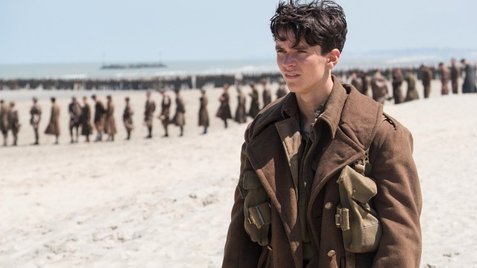
It might be a little extreme to say that Dunkirk has single-handedly saved cinema, but let’s just say that, in a time when prestige TV is hogging lots of attention (and deservedly so!), Christopher Nolan’s stunning WWII saga makes a pretty strong case for the continued sustenance of film. The movie is an injection of pure cinema: It’s filled with arresting images which it uses to stir, to terrify, and at times to nearly overwhelm its audience. You shouldn’t wait for this one to come out on Netflix or, God forbid, watch it on your iPhone. You should see it on as big a screen as possible, ideally an IMAX that accommodates the 70mm film it was shot on.
Dunkirk tells an unlikely but true story that has long been the stuff of British folklore, but may not be as well known to us Yanks. During World War II, thousands of Allied soldiers—the majority of whom were British—were stranded on the shores of Dunkirk, France and surrounded by Nazis, who could easily pick them off from the skies “like fish in a barrel,” as steely Commander Bolton (Kenneth Branagh) notes. The soldiers could literally see home from across the English Channel, but were helpless to get there.
Nolan tells his story on three surfaces: Land, sky, and water.
On land, we follow a young British soldier named Tommy (Fionn Whitehead), who, like the rest of his exhausted and terrified mates—including, yes, the dreamy Harry Styles from One Direction, who acquits himself more than ably—simply wants to get off the beach and go home. These scenes on the beach—and on the handful of ships on which the the soldiers desperately jostle and shove to get aboard—are among the most breathtaking. Nolan gives us an incredible sense of the scope of the allied troops—all 400,000 of them—and their terrifying vulnerability. Overhead, a German bomber will approach, and they’ll all duck in a kind of harrowing and beautiful choreography, their helmets providing only the illusion of cover against the assault that’s about to come. But no place is safe. On the ships, they are met with torpedoes, gun fire, and more bombs. Even the water itself, when mixed with oil, is sometimes engulfed in flames. It’s chaos, with no safe havens.
In the sky, we meet two Allied fighter pilots, Farrier (Tom Hardy) and Collins (Jack Lowden). Farrier is losing fuel; Collins is already out. Collins navigates a risky water landing, leaving Farrier is on his own, in a race against the clock to shoot down as many German planes as possible before he’s forced to land.
In the water, we are introduced to the everyman hero Dawson (Mark Rylance), who, along with his son, Peter (Tom Glynn-Carney) and the sweet, naive neighborhood boy George (Barry Keoghan), has heeded a call for civilians to take to their own boats and help rescue the stranded soldiers. At one point in their journey, they rescue a shell-shocked soldier (Cillian Murphy) who’s clinging to life on a downed jet. The soldier is angry and stunned when he sees which way the small boat is heading.
With a lean running time of one hour, 47 minutes, Dunkirk is a tone poem of sorts—with minimal dialogue (all the better, since some of the British accents are a bit challenging) and a nervewracking, horror-film-like score that will keep you gripped to your seat and occasionally reminding yourself to breathe.
A note on the film’s structure: Nolan has created another one of his famous puzzles here—the events depicted in the film seem to be happening at the same time, but they are, in fact, in different time frames (although they do ultimately converge at the end). When the film was over, a small part of me felt compelled to map out a chronology of what I had just seen to see how it all fit, and, although I resisted the urge, I’m sure many Nolan fans will do just that (I’m equally sure the puzzle will fit perfectly). The craftsmanship here is undeniably impeccable, but I believe the film could’ve easily been told in a conventional way without losing any of its wonder and power. Still, that’s a minor quibble. Dunkirk is an extraordinary achievement—a tremendous work of artistry and entertainment that ranks among the best war films I’ve ever seen.
